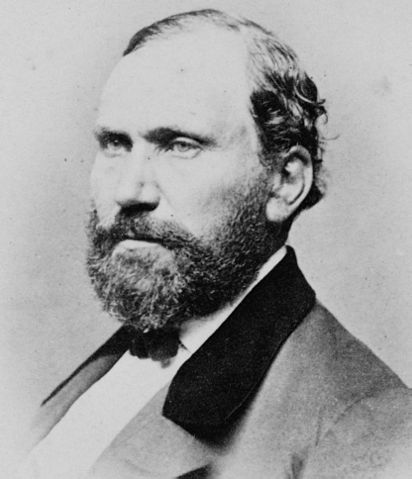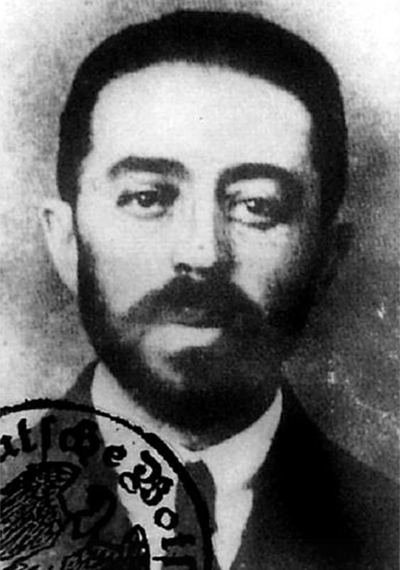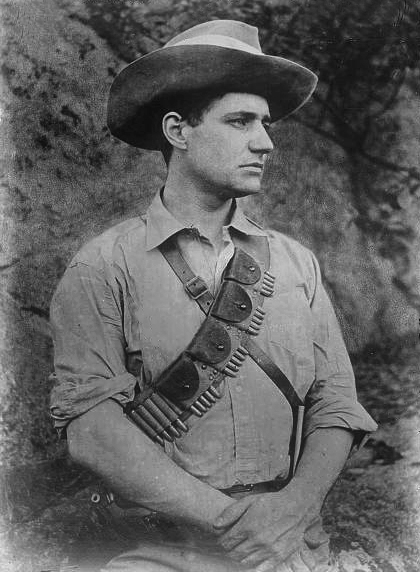Although most people think of spies as a Cold War phenomenon, they’ve actually been around for hundreds of years, and include in their ranks larger than life figures like big game hunters, revolutionary war heroes, and even exotic dancers. While these real life spies might not have had cool gadgets or fast cars like James Bond, their lives still make for some pretty amazing stories, so sit back with a shaken-not-stirred martini and have a look at this list of the top ten masters of espionage throughout history.
10. Allan Pinkerton

Allan Pinkerton was a Scottish detective who pioneered many spying techniques that are still used today. He was one of the first detectives to shadow his subjects, and his undercover operations, what he called “assuming a role,” helped shape modern espionage. In 1850 he founded the Pinkerton National Detective Agency, a group of private detectives and policemen.
The group was well known throughout the 1800s, and is best remembered for their involvement in the tracking and capture of several old west outlaws. During the American Civil War, Pinkerton was the head of the Union Intelligence Service, and was a close advisor and confidant to Abraham Lincoln. He helped foil an assassination plot on Lincoln in 1861, planted agents inside the Confederate army, and even went undercover as a Confederate officer in order to report on troop movements.
9. Klaus Fuchs

A German theoretical physicist and an expert on atomic bomb technology, Klaus Fuchs passed on a number of significant weapons secrets to the USSR while working as a scientist for the American government. Fuchs made a number of breakthroughs in nuclear fission, and was a part of the famed Manhattan Project that led to the development of the first A-bomb.
A communist in his youth, he was recruited by a KGB case officer in 1941, and for years he passed on information about bomb technology and the state of the U.S. weapons stockpile to the Soviets. Fuchs was apprehended in 1946 after a Soviet cipher was cracked by Allied intelligence forces, and under interrogation he admitted to working for the Russians. While he is not as well known as Julius and Ethel Rosenberg, the atomic secrets provided by Klaus Fuchs are said to have had a bigger effect on the Russians’ knowledge of the U.S. nuclear program, and even helped aid them in the development of their own atomic weapons.
8. Elizabeth Van Lew

Elizabeth Van Lew was a spy who worked on behalf of the Union during the American Civil War. Van Lew operated under the cover of a charity worker, and was allowed to enter the infamous Libby Prison in the Southern capital of Richmond to bring Union prisoners food and supplies. While there, she would gather information about Confederate troop movements and pass it on to U.S. forces.
She also operated a small spy ring that was based out of Richmond and included several high profile members of the Confederate government, and it is rumored that she even managed to get one of her former slaves hired on at the White House of the Confederacy to act as an informant. After the war ended, Van Lew was credited by Ulysses Grant as the most valuable source of information on the Confederate capital city. Along with Belle Boyd on the Southern side, she is remembered as the most famous spy of the Civil War, and she was eventually inducted into the Military Intelligence Hall of Fame.
7. Aldrich Ames

While most spies engage in espionage for political or ideological reasons, for CIA mole Aldrich Ames the motivation was purely monetary. Ames, who worked as a counter-intelligence analyst in Washington D.C., was desperate for cash, and in 1985 he began supplying secrets to the Soviets in exchange for a fee, eventually receiving over $4 million from the Russians. Over the course of nine years, Ames supplied the Soviets with countless secrets, including the names of over 100 U.S. informants working in Russia, at least ten of whom were eventually executed.
Ames used his millions to fund a lavish lifestyle, which attracted the attention of the CIA, but thanks to his intelligence training he was able to repeatedly pass lie detector tests. He was finally arrested in 1994, and after pleading guilty to spying, was sentenced to life in prison. Interestingly, at least $2 million of his fee remains in an undisclosed bank account, and to this day the Russians have refused to turn this money over to American authorities.
6. Richard Sorge

Richard Sorge in the hospital, during World War I.Considered to be one of the most skilled spies of the 20th century, Richard Sorge was a Soviet master of espionage who worked all over the world before and during World War II. For much of his career, he operated under the cover of a professional journalist, traveling to various European countries to calculate the chances of possible Communist uprisings.
At the outbreak of WWII, Sorge traveled to Japan under the guise of a Nazi reporter and began supplying the Soviets with valuable intelligence about Japanese and German combat operations. He warned them about the Pearl Harbor attack, the planned German invasion of Russia, and countless other missions, but a lot of his intelligence was ignored by Stalin. Sorge was eventually captured by the Japanese in 1944, and though he never admitted to being a Soviet spy even under torture, was executed shortly thereafter. The Soviets did not recognize him or his activities until 1964, at which point he was belatedly hailed as a national hero.
5. Sidney Reilly

One of the major models for the James Bond character, Sidney Reilly was a master spy who worked for a number of governments in the early 20th century. Known as the “Ace of Spies,” Reilly was an expert at deception and self-promotion, so a lot of the information on his life is unreliable. We do know that he was a master of disguise, and frequently crossed national borders under assumed identities in order to steal military secrets, building plans, and aircraft prototypes. He was also known for his debonair character, and often used his charm to seduce the wives of politicians and military officers in order to get information from them.
In his most famous exploit, Reilly worked as the leader of a British intelligence group involved in trying to overthrow the Bolshevik government in Russia in 1917. He helped stage an unsuccessful coup, and led an attempted assassination plot on Vladimir Lenin, but his group was eventually found out and he only narrowly escaped arrest by assuming the identity of German national and escaping to Finland. He was sentenced to death in absentia by the Russian government, and in 1925 he was lured to back into the Soviet Union as a part of a sting operation and captured. Though he never admitted to being a spy, he was eventually executed by firing squad.
4. Fritz Joubert Duquesne
Fritz Joubert Duquesne was a larger than life writer, soldier, and adventurer who gained fame as a spy for the Germans during World Wars I and II. As a young man, he fought against England in his native South Africa during the First and Second Boer Wars, at one point enlisting in the British army in order to sabotage missions and report on troop movements. This experience helped foster a lifelong hatred of all things English, and at the outbreak of the First World War, Duquesne began working for the Germans as a spy, planting bombs on several British ships that eventually went down at sea.
He was captured in 1917 and extradited to New York, but after two years in jail he made a daring escape by cutting through the bars of his cell and scaling the prison walls. He disappeared for some time, working as a freelance journalist and even writing his own biography, before resurfacing at the outbreak of WWII and resuming his spy activities for the Germans. His days of espionage came to an end in 1942 when Duquesne, along with 33 other German spies, were arrested in what became known as the biggest espionage ring conviction in American history.
3. Nathan Hale

Considered by many to be America’s first spy, Nathan Hale was a soldier in the Continental Army who in 1776 volunteered to go on a dangerous intelligence-gathering mission behind enemy lines. Hale, who was only 21 at the time, ventured into New York City in disguise in order to report on British troop movements, but after the city fell to the English, he was found out by a British officer and captured. Although spying wasn’t widely practiced at the time, Hale was charged with being an illegal combatant and was hanged a few days after being apprehended. Before his execution, he is said to have uttered the now famous line “I regret that I have but one life to give for my country.” This speech and his espionage activities cemented Hale’s reputation as one of the heroes of the Revolutionary War, and to this day a statue of him stands outside of the CIA headquarters.
2. Kim Philby

Perhaps the most famous double agent of the Cold War, Kim Philby was a globetrotting British spy who was in actuality a socialist under the control of the Soviet KGB. In a career that took him to Spain, Africa, the U.S., Istanbul, and Moscow, Philby gained a reputation as one of Britain’s most capable spies, but all the while he was secretly sending along information to the Soviet Embassy in Paris. In the late forties, he was assigned to act as an intermediary between the British and U.S. intelligence organizations in Washington D.C. During this time, he passed along significant information on U.S. armaments and atomic weapons stockpiles, and many credit these reports with influencing Josef Stalin’s political decisions and helping to lead to the Korean War. Philby was suspected as a possible Soviet spy by British intelligence throughout his career, but they were unable to prove anything, and he remained on the periphery of the intelligence community until he defected to the Soviet Union in 1963. He continued to work in Soviet intelligence until his death in 1988, when he was given numerous posthumous awards by the Russian government.
1. Mata Hari

Now recognized as the prototypical femme fatale, Margaretha Geertruida Zelle, AKA Mata Hari, was a famous exotic dancer and performer who was executed in 1917 for spying for the Germans during World War I. She gained fame in Paris for her risqué dance routines and performances, and at the outbreak of the war she was the mistress and escort to many high profile businessman and military officers. As a citizen of the neutral Netherlands, Mata Hari frequently crossed national borders, a practice that eventually attracted the attention of the Allies.
When questioned by British intelligence, she claimed to be an undercover spy for the French, but their government denied this. Soon after, the French intercepted a German radio transmission detailing the activities of one of their most successful spies. Evidence pointed to Mata Hari as the culprit, and she was quickly arrested and charged with contributing to the deaths of 50,000 people. She was found guilty during a trial and executed in October of 1917 by firing squad. Although it has never been determined whether she was really working for the Germans or the French, Mata Hari continues to be remembered as one of the most famous spies of all time.

12 Comments
Wow I always wanted to be a spy but after reading this no thank you I m good as an average person
Sorge might not be the best known one but probably the most effective one. Because he told the Russians that the Japanese were not going to attack Russia and instead Pearl Harbor Stalin was able to move 10 fresh divisions to Stalingrad. Guess he never send a memo to Rossevelt, or maybe he did as he was itching to join the war.
Then there was the “spy from Damascus” … Eli Cohen who was probably the greatest spy during the second half of last century
Forgot to ask for followup comments via email, so again: Does anyone know the year that Elizabeth Van Lew was inducted into the Military Intelligence Corps Hall of Fame?
Thank you.
Fascinating information; some well-known and some new to me.
Does anyone know the year that Elizabeth Van Lew was inducted into the Military Intelligence Corps Hall of Fame? Her co-conspirator, Mary Elizabeth Bowser, was inducted in 1995. Incidentally, the Hall opened in 1988.
Thanks.
i just wanted to know so i can put them in my story i have to do so THANKS!!!!!
These might be the the Top 10 spies that got caught, but what truly makes a good spy is one who never gets caught and their existence as a spy is never known.
i think this list is far too westernized, you should also include kawashima yoshiko, she was a Manchu princess brought up in Japan and working as a spy for Japanese. She is sometimes referred as eastern mata hari.
IN SOME DEVIANT AND DEVIOUS MEANS AND WAYS THESE GUYS DID MORE FOR WORLD PEACE THAN MANY UNITED NATIONS' PEACE FORCES MAY HAVE DONE SO FAR.
SPYING IS A WAY TO DIMINISH THE BURDEN OF ANXIETY, OR FEAR OF NOT KNOWING WHAT YOUR ENEMY IS UP TO, IN EITHER SIDE.
MANY OF THESE GUYS SHOULD THE BROUGHT TO SAINTHOOD FOR SAVING LOTS OF PEOPLE'S LIVES, EXACTLY THOSE WHO DID NOT HAVE TO GO TO WAR TO DEFEND PEACE, A MAJOR BULL OF POWERFUL NATIONS' FORMS OF SUBDUING BELLIGERENCE.
You should add Harriet Tubman. She didn't just help slaves escape the south thru the underground railroad, she was an astute spy for the North too.
And even though she was black and female, she eventually was given a soldiers pension for her Civil War efforts.
I found out the other day that the inventor of the theremin Mr. Theramin was a USSR spy. He would travel around the world collecting information for Mother Russia under the guise of demonstrating his new musical instrument. I found that pretty interesting.
Hi, Gwen. Great comment as always. Thanks for bringing the knowledge!